Effects of Dandelion Extract on Promoting Production Performance and Reducing Mammary Oxidative Stress in Dairy Cows Fed High-Concentrate Diet
Abstract
:1. Introduction
2. Results
2.1. Effects of Different Diets on Milk Production, Feed Intake, and Milk Synthesis Efficiency of Dairy Cows
2.2. Effects of Different Diets on Milk Somatic Cell Count (SCC) and Milk Quality of Dairy Cows
2.3. Effects of Different Diets on Rumen pH, LPS Concentration in the Rumen Fluid, and Plasma of Dairy Cows
2.4. Effects of Different Diets on the Concentration of Oxidative Damage Markers and Antioxidant Enzyme Activities in Serum
2.5. Analysis of Correlation between Plasma LPS Concentration and Oxidative Damage Markers and Antioxidant Enzyme Activities
2.6. Effects of Different Diets on mRNA Expression of Genes Related to Lactation
2.7. Effects of Different Diets on mRNA Expression of Antioxidant-Related Genes
3. Discussion
4. Materials and Methods
4.1. Ethic Statement
4.2. Animal, Experiment Design, Feeding Management, and DAE
4.3. Sample Collection, Production Performance, and Isolation of Mammary Epithelial Cells
4.4. Determination of LPS
4.5. Determination of Oxidative Damage Markers and Antioxidant Enzyme Activity
4.6. Isolation of RNA, cDNA Synthesis, and Quantitative Real-Time PCR (qPCR)
4.7. Statistical Analysis
5. Conclusions
Supplementary Materials
Author Contributions
Funding
Institutional Review Board Statement
Informed Consent Statement
Data Availability Statement
Conflicts of Interest
References
- Fiore, E.; Arfuso, F.; Gianesella, M.; Vecchio, D.; Morgante, M.; Mazzotta, E.; Badon, T.; Rossi, P.; Bedin, S.; Piccione, G. Metabolic and hormonal adaptation in Bubalus bubalis around calving and early lactation. PLoS ONE 2018, 13, e0193803. [Google Scholar] [CrossRef] [PubMed]
- Fiore, E.; Gianesella, M.; Arfuso, F.; Giudice, E.; Piccione, G.; Lora, M.; Stefani, A.; Morgante, M. Glucose infusion response on some metabolic parameters in dairy cows during transition period. Arch. Anim. Breed. 2014, 57, 3. [Google Scholar] [CrossRef]
- Bazzano, M.; Giannetto, C.; Fazio, F.; Arfuso, F.; Giudice, E.; Piccione, G. Metabolic Profile of Broodmares During Late Pregnancy and Early Post-Partum. Reprod. Domest. Anim. 2014, 49, 947–953. [Google Scholar] [CrossRef] [PubMed]
- Xu, T.; Tao, H.; Chang, G.; Zhang, K.; Xu, L.; Shen, X. Lipopolsaccharide derived from the rumen down-regulates, stearoyl-CoA desaturase 1 expression and alters fatty acid composition in the liver of dairy cows fed a high-concentrate diet. BMC Vet. Res. 2015, 11, 52–63. [Google Scholar] [CrossRef] [PubMed]
- Steele, M.A.; Croom, J.; Kahler, M.; AlZahal, O.; Hook, S.E.; Plaizier, K.; McBride, B.W. Bovine rumen epithelium undergoes rapid structural adaptations during grain-induced subacute ruminal acidosis. Am. J. Physiol.-Regul. Integr. Comp. Physiol. 2011, 300, R1515–R1523. [Google Scholar] [CrossRef] [PubMed]
- Owens, F.N.; Secrist, D.S.; Hill, W.J.; Gill, D.R. Acidosis in cattle: A review. J. Anim. Sci. 1998, 76, 275–286. [Google Scholar] [CrossRef] [PubMed]
- Zhang, H.; Jin, Y.; Peng, A.; Guo, S.; Loor, J.J.; Wang, H. L-Arginine protects ovine intestinal epithelial cells from lipopolysaccharide-induced intestinal barrier injury. Food Agric. Immunol. 2019, 30, 1067–1084. [Google Scholar] [CrossRef]
- Gozho, G.N.; Krause, D.O.; Plaizier, J.C. Ruminal lipopolysaccharide concentration and inflammatory response during grain-induced subacute ruminal acidosis in dairy cows. J. Dairy Sci. 2007, 90, 856–866. [Google Scholar] [CrossRef] [PubMed]
- Emmanuel, D.G.V.; Dunn, S.M.; Ametaj, B.N. Feeding high proportions of barley grain stimulates an inflammatory response in dairy cows. J. Dairy Sci. 2008, 91, 606–614. [Google Scholar] [CrossRef]
- Khafipour, E.; Krause, D.O.; Plaizier, J.C. A grain-based subacute ruminal acidosis challenge causes translocation of lipopolysaccharide and triggers inflammation. J. Dairy Sci. 2009, 92, 1060–1070. [Google Scholar] [CrossRef]
- Dong, G.; Qiu, M.; Ao, C.; Zhou, J.; Erdene, K.; Wang, X.; Zhang, Z.; Yang, Y. Feeding a high-concentrate corn straw diet induced epigenetic alterations in the mammary tissue of dairy cows. PLoS ONE. 2014, 9, e107659. [Google Scholar] [CrossRef] [PubMed]
- Silanikove, N.; Rauch-Cohen, A.; Shapiro, F.; Arieli, A.; Merin, U.; Leitner, G. Lipopolysaccharide challenge of the mammary gland in cows induces nitrosative stress that impairs milk oxidative stability. Animal 2012, 6, 1451–1459. [Google Scholar] [CrossRef] [PubMed]
- Schütz, K.; Carle, R.; Schieber, A. Taraxacum—A review on its phytochemical and pharmacological profile. J. Ethnopharmacol. 2006, 107, 313–323. [Google Scholar] [CrossRef] [PubMed]
- González-Castejón, M.; Visioli, F.; Rodriguez-Casado, A. Diverse biological activities of dandelion. Nutr. Rev. 2012, 70, 534–547. [Google Scholar] [CrossRef] [PubMed]
- Hu, C.; Kitts, D.D. Antioxidant, Prooxidant, and cytotoxic activities of solvent fractionated dandelion (Taraxacum officinale) flower extracts in vitro. J. Agric. Food Chem. 2003, 51, 301–310. [Google Scholar] [CrossRef] [PubMed]
- Estabrook, R.W.; Shet, M.S.; Fisher, C.W.; Jenkins, C.M.; Waterman, M.R. The interaction of NADPH-P450 reductase with P 450: An electrochemical study of the role of the flavin mononucleotide-binding domain. Arch. Biochem. Biophys. 1996, 333, 308–315. [Google Scholar] [CrossRef] [PubMed]
- Hu, C.; Kitts, D.D. Dandelion (Taraxacum officinale) flower extract suppress both reactive oxygen species and nitric oxide and prevents lipid oxidation in vitro. Phytomedicine 2005, 12, 588–597. [Google Scholar] [CrossRef] [PubMed]
- Park, C.M.; Park, J.Y.; Noh, K.H.; Shin, J.H.; Song, Y.S. Taraxacum officinale Weber extracts inhibit LPS-induced oxidative stress and nitric oxide production via the NF-κB modulation in RAW 264.7 cells. J. Ethnopharmacol. 2011, 133, 834–842. [Google Scholar] [CrossRef] [PubMed]
- Xue, Y.; Zhang, S.; Du, M.; Zhu, M.-J. Dandelion extract suppresses reactive oxidative species and inflammasome in intestinal epithelial cells. J. Funct. Foods 2017, 29, 10–18. [Google Scholar] [CrossRef]
- Sumanth, M.; Rana, A.C. In vivo antioxidant activity of hydroalcoholic extract of Taraxacum officinale roots in rats. Res. Lett. 2006, 38, 54–55. [Google Scholar] [CrossRef]
- Choi, U.-K.; Lee, O.-H.; Yim, J.H.; Cho, C.-W.; Rhee, Y.K.; Lim, S.-I.; Kim, Y.-C. Hypolipidemic and antioxidant effects of dandelion (Taraxacum officinale) root and leaf on cholesterol-fed rabbits. Int. J. Mol. Sci. 2010, 11, 67–78. [Google Scholar] [CrossRef]
- Zhou, J.; Dong, G.; Ao, C.; Zhang, S.; Qiu, M.; Wang, X.; Wu, Y.; Erdene, K.; Jin, L.; Lei, C.; et al. Feeding a high-concentrate corn straw diet increased the release of endotoxin in the rumen and pro-inflammatory cytokines in the mammary gland of dairy cows. BMC Vet. Res. 2014, 10, 172–181. [Google Scholar] [CrossRef]
- Abaker, J.A.; Xu, T.L.; Jin, D.; Chang, G.J.; Zhang, K.; Shen, X.Z. Lipopolysaccharide derived from the digestive tract provokesoxidative stress in the liver of dairy cows fed a high-grain diet. J. Dairy Sci. 2016, 100, 666–678. [Google Scholar] [CrossRef] [PubMed]
- Zhan, J.; Liu, M.; Su, X.; Zhan, K.; Zhang, C.; Zhao, G. Effects of alfalfa flavonoids on the production performance, inmmune system, and ruminal fermentation of dairy cows. Asian-Australas. J. Anim. Sci. 2017, 30, 1416–1424. [Google Scholar] [CrossRef]
- Aguiar, S.; Cottica, S.; Boeing, J.; Samensari, R.; Santos, G.; Visentainer, J.; Zeoula, L. Effect of feeding phenolic compounds from propolis extracts to dairy cows on milk production, milk fatty acid composition, and the antioxidant capacity of milk. Anim. Feed Sci. Technol. 2014, 193, 148–154. [Google Scholar] [CrossRef]
- Gessner, D.; Koch, C.; Romberg, F.-J.; Winkler, A.; Dusel, G.; Herzog, E.; Most, E.; Eder, K. The effect of grape seed and grape marc meal extract on milk performance and the expression of genes of endoplasmic reticulum stress and inflammation in the liver of dairy cows in early lactation. J. Dairy Sci. 2015, 98, 8856–8868. [Google Scholar] [CrossRef]
- Winkler, A.; Gessner, D.K.; Koch, C.; Romberg, F.-J.; Dusel, G.; Herzog, E.; Most, E.; Eder, K. Effects of a plant product consisting of green tea and curcuma extract on milk production and the expression of hepatic genes involved in endoplasmic stress response and inflammation in dairy cows. Arch. Anim. Nutr. 2015, 69, 425–441. [Google Scholar] [CrossRef]
- Krajcarski-Hunt, H.; Plaizier, J.; Walton, J.-P.; Spratt, R.; McBride, B. Effect of subacute ruminal acidosis on in situ fiber digestion in lactating dairy cows. J. Dairy Sci. 2002, 85, 570–573. [Google Scholar] [CrossRef]
- Oba, M.; Allen, M.S. Extent of hypophagia caused by propionate infusion is related to plasma glucose concentration in lactating dairy cows. J. Nutr. 2003, 133, 1105–1112. [Google Scholar] [CrossRef] [PubMed]
- Allen, M.S. Effects of diet on short-term regulation of feed intake by lactating dairy cattle. J. Dairy Sci. 2000, 83, 1598–1624. [Google Scholar] [CrossRef]
- Waldron, M.R.; Nishida, T.; Nonnecke, B.J.; Overton, T.R. Effect of lipopolysaccharide on indices of perheral and hepatic metabolism in lactating cows. J. Dairy Sci. 2003, 86, 3447–3459. [Google Scholar] [CrossRef] [PubMed]
- Wellnitz, O.; Arnold, E.T.; Bruckmaier, R.M. Lipopolysaccharide and lipoteichoic acid induce different immune responses in the bovine mammary gland. J. Dairy Sci. 2011, 94, 5405–5412. [Google Scholar] [CrossRef] [PubMed]
- Vernay MC, M.B.; Wellnitz, O.; Kreipe, L.; Van Dorland, H.A.; Bruckmaier, R.M. Local and systemic response to intramammary lipopolysaccharide challenge during long-term manipulated plasma glucose and insulin concentration in dairy cows. J. Dairy Sci. 2012, 95, 2540–2549. [Google Scholar] [CrossRef] [PubMed]
- Olagaray, K.E.; Bradford, B.J. Plant flavonoids to improve productivity of ruminants—A review. Anim. Feed Sci. Technol. 2019, 251, 21–36. [Google Scholar] [CrossRef]
- Nocek, J.E. Bovine acidosis: Implications on laminitis. J. Dairy Sci. 1997, 80, 1005–1028. [Google Scholar] [CrossRef] [PubMed]
- Zebeli, Q.; Ametaj, B.N. Relationships between rumen lipopolysaccharide and mediators of inflammatory response with milk fat production and efficiency in dairy cows. J. Dairy Sci. 2009, 92, 3800–3809. [Google Scholar] [CrossRef] [PubMed]
- Cant, J.P.; Trout, D.R.; Qiao, F.; Purdie, N.G. Milk synhtetic response of the bovine mammary gland to increase in the local concentration of arterial glucose. J. Dairy Sci. 2002, 3, 494–503. [Google Scholar] [CrossRef] [PubMed]
- Garavaglia, L.; Galletti, S.; Tedesco, D. Silymarin and lycopene administration in periparturient dairy cows: Effects on milk production and oxidative status. N. Z. Vet. J. 2015, 63, 313–318. [Google Scholar] [CrossRef] [PubMed]
- Gressley, T.F.; Hall, M.B.; Armentano, L.E. Productivity, digestion, and health responses to hindgut acidosis in ruminants. J. Amin. Sci. 2011, 89, 1120–1130. [Google Scholar]
- Berger, L.M.; Wein, S.; Blank, R.; Metges, C.C.; Wolffram, S. Bioavailability of the flavonol quercetin in cows after intraruminal application of quercetin aglycone and rutin. J. Dairy Sci. 2012, 95, 5047–5055. [Google Scholar] [CrossRef]
- De Nardi, R.; Marchesini, G.; Plaizier, J.C.; Li, S.; Khafipour, E.; Ricci, R.; Andrighetto, I.; Segato, S. Use of dicarboxylic acids and polyphenols to attenuate reticular pH drop and acute phase response in dairy heifers fed a high grain diet. BMC Vet. Res. 2014, 10, 277–284. [Google Scholar] [CrossRef]
- Balcells, J.; Aris, A.; Serrano, A.; Seradj, A.R.; Crespo, J.; Devant, M. Effects of an extract of plant flavonoids (Bioflavex) on rumen fermentation and performance in heifers fed high-concentrated diets. J. Anim. Sci. 2012, 90, 4975–4984. [Google Scholar] [CrossRef] [PubMed]
- Nagaraja, T.G.; Titgemeyer, E.C. Ruminal acidosis in beef cattle: The current microbiological and nutritional outlook. J. Dairy Sci. 2007, 90, E17–E38. [Google Scholar] [CrossRef]
- Ellah, M.R.A. Involvement of free radicals in animal diseases. Comp. Clin. Pathol. 2010, 19, 615–619. [Google Scholar] [CrossRef]
- Dong, G.; Liu, S.; Wu, Y.; Lei, C.; Zhou, J.; Zhang, S. Diet-induced bacterial immunogens in the gastrointestinal tract of dairy cows: Impacts on immunity and metabolism. Acta Vet. Scand. 2011, 53, 48–54. [Google Scholar] [CrossRef]
- Mier-Cabrera, J.; Jiménez-Zamudio, L.; García-Latorre, E.; Cruz-Orozco, O.; Hernández-Guerrero, C. Quantitative and qualitative peritoneal immune profiles, T cell apoptosis and oxidative stress associated characteristics in women with minimal and milk endometriosis. BJOG Int. J. Obstet. Gynaecol. 2011, 188, 6–16. [Google Scholar] [CrossRef]
- Boulanger, V.; Zhao, X.; Lacasse, P. Protective effect of melatonin and catalase in bovine neutrophil-induced model of mammary cell damage. J. Dairy Sci. 2002, 85, 562–569. [Google Scholar] [CrossRef]
- Schnabel, K.; Schmitz, R.; Frahm, J.; Meyer, U.; Breves, G.; Dänicke, S. Functionality and DNA-damage properties of blood cells in lactating cows exposed to glyphosate contaminated feed at different feed energy levels. Arch. Anim. Nutr. 2020, 74, 87–106. [Google Scholar] [CrossRef] [PubMed]
- Guo, Y.; Xu, X.; Zou, Y.; Yang, Z.; Li, S.; Cao, Z. Changes in feed intake, nutrient digestion, plasma metabolites, and oxidative stress parameters in dairy cows with subacute ruminal acidosis and its regulation with pelleted beet pulp. J. Anim. Sci. Biotechnol. 2013, 4, 31–40. [Google Scholar] [CrossRef]
- Lawler, J.M.; Song, W. Specificity of antioxidant enzyme inhibition in skeletal muscle to reactive nitrogen species donors. Biochem. Biophys. Res. Commun. 2002, 294, 1093–1100. [Google Scholar] [CrossRef]
- Zhao, J.; Zhang, G.; Zhou, X.; Dong, W.; Wang, Q.; Xiao, C.; Zhang, S. Effect of dandelion root extract on growth performance, immune function and bacterial community in weaned pigs. Food Agric. Immunol. 2019, 30, 95–111. [Google Scholar] [CrossRef]
- Shabtay, A.; Eitam, H.; Tadmor, Y.; Orlov, A.; Meir, A.; Weinberg, P.; Weinberg, Z.G.; Chen, Y.; Brosh, A.; Izhaki, I.; et al. Nutritive and antioxidative potential of fresh and stored pomegranate industrial byproduct as a novel beef cattle feed. J. Agric. Food Chem. 2008, 56, 10063–10070. [Google Scholar] [CrossRef] [PubMed]
- Gladine, C.; Rock, E.; Morand, C.; Bauchart, D.; Durand, D. Bioavailability and antioxidant capacity of plant extracts rich in polyphenols, given as a single acute dose, in sheep made highly susceptible to lipoperoxidation. Br. J. Nutr. 2007, 98, 691–701. [Google Scholar] [CrossRef] [PubMed]
- Gobert, M.; Martin, B.; Ferlay, A.; Chilliard, Y.; Graulet, B.; Pradel, P.; Bauchart, D.; Durand, D. Plant polyphenols associated with vitamin E can reduce plasma lipoperoxidation in dairy cows given n-3 polyunsaturated fatty acids. J. Dairy Sci. 2009, 92, 6095–6104. [Google Scholar] [CrossRef]
- Gohlke, A.; Ingelmann, C.; Nürnberg, G.; Weitzel, J.; Hammon, H.; Görs, S.; Starke, A.; Wolffram, S.; Metges, C. Influence of 4-week intraduodenal supplementation of quercetin on performance, glucose metabolism, and mRNA abundance of genes related to glucose metabolism and antioxidative status in dairy cows. J. Dairy Sci. 2013, 96, 6986–7000. [Google Scholar] [CrossRef] [PubMed]
- Zhang, K.; Chang, G.; Xu, T.; Xu, L.; Guo, J.; Jin, D.; Shen, X. Lipopolysaccharide derived from the digestive tract activates inflammatory gene expression and inhibits casein synthesis in the mammary glands of lactating dairy cows. Oncotarget 2016, 7, 9652–9665. [Google Scholar] [CrossRef] [PubMed]
- Günther, J.; Koczan, D.; Yang, W.; Nürnberg, G.; Repsilber, D.; Schuberth, H.-J.; Park, Z.; Maqbool, N.; Molenaar, A.; Seyfert, H.-M. Assessment of the immune capacity of mammary epithelial cells: Comparison with mammary tissue after challenge with Escherichia coli. Vet. Res. 2009, 40, 31. [Google Scholar] [CrossRef]
- Chang, G.; Wang, L.; Ma, N.; Zhang, W.; Zhang, H.; Dai, H.; Shen, X. Histamine activates inflammatory response and depresses casein synthesis in mammary gland of dairy cows during SARA. BMC Vet. Res. 2018, 14, 168–176. [Google Scholar] [CrossRef] [PubMed]
- Suburu, J.; Shi, L.; Wu, J.; Wang, S.; Samuel, M.; Thomas, M.J.; Kock, N.D.; Yang, G.; Kridel, S.; Chen, Y.Q. Fatty acid synthase is required for mammary gland development and milk production during lactation. Am. J. Physiol. Endocrinol. Metab. 2014, 306, E1132–E1143. [Google Scholar] [CrossRef]
- Chen, J.; Wu, Y.; Sun, Y.; Dong, X.; Wang, Z.; Zhang, Z.; Xiao, Y.; Dong, G. Bacterial lipopolysaccharide induced alterations of genome-wide dna methylation and promoter methylation of lactation-related genes in bovine mammary epithelial cells. Toxins 2019, 11, 298. [Google Scholar] [CrossRef]
- Tian, P.; Luo, Y.; Li, X.; Tian, J.; Tao, S.; Hua, C.; Geng, Y.; Ni, Y.; Zhao, R. Negative effects of long-term feeding of high-grain diets to lactating goats on milk fat production and composition by regulating gene expression and DNA methylation in the mammary gland. J. Anim. Sci. Biotechnol. 2017, 8, 74–84. [Google Scholar] [CrossRef] [PubMed]
- Sandri, E.C.; Levesque, J.; Marco, A.; Couture, Y.; Gervais, R.; Rico, D.E. Transient reductions in milk fat synthesis and their association with the ruminal and metabolic profile in dairy cows fed high-starch, low-fat diets. Animal 2020, 14, 2523–2534. [Google Scholar] [CrossRef] [PubMed]
- Memon, M.A.; Wang, Y.; Xu, T.; Ma, N.; Zhang, H.; Roy, A.C.; ul Aabdin, Z.; Shen, X. Lipopolysaccharide induces oxidative stress by triggering MAPK and Nrf2 signaling pathways in mammary glands of dairy cows fed a high-concentrate diet. Microb. Pathog. 2019, 128, 268–275. [Google Scholar] [CrossRef] [PubMed]
- Schogor, A.L.B.; Palin, M.-F.; dos Santos, G.T.; Benchaar, C.; Lacasse, P.; Petit, H.V. Mammary gene expression and activity of antioxidant enzymes and oxidative indicators in the blood, milk, mammary tissue and ruminal fluid of dairy cows fed flax meal. Br. J. Nutr. 2013, 110, 1743–1750. [Google Scholar] [CrossRef] [PubMed]
- Han, L.; Batistel, F.; Ma, Y.; Alharthi AS, M.; Parys, C.; Loor, J.J. Methionine supply alters mammary gland antioxidant genenetworks via phosphorylation of nuclear factor erythroid 2-like 2 (NFE2L2) protein in dairy cows during the periparturient period. J. Dairy Sci. 2018, 101, 8505–8512. [Google Scholar] [CrossRef]
- Sun, Y.; Wu, Y.; Wang, Z.; Chen, J.; Yang, Y.; Dong, G. Dandelion extract alleviated lipopolysaccharide-induced oxidative stress through the nrf2 pathway in bovine mammary epithelial cells. Toxins 2020, 12, 496. [Google Scholar] [CrossRef]
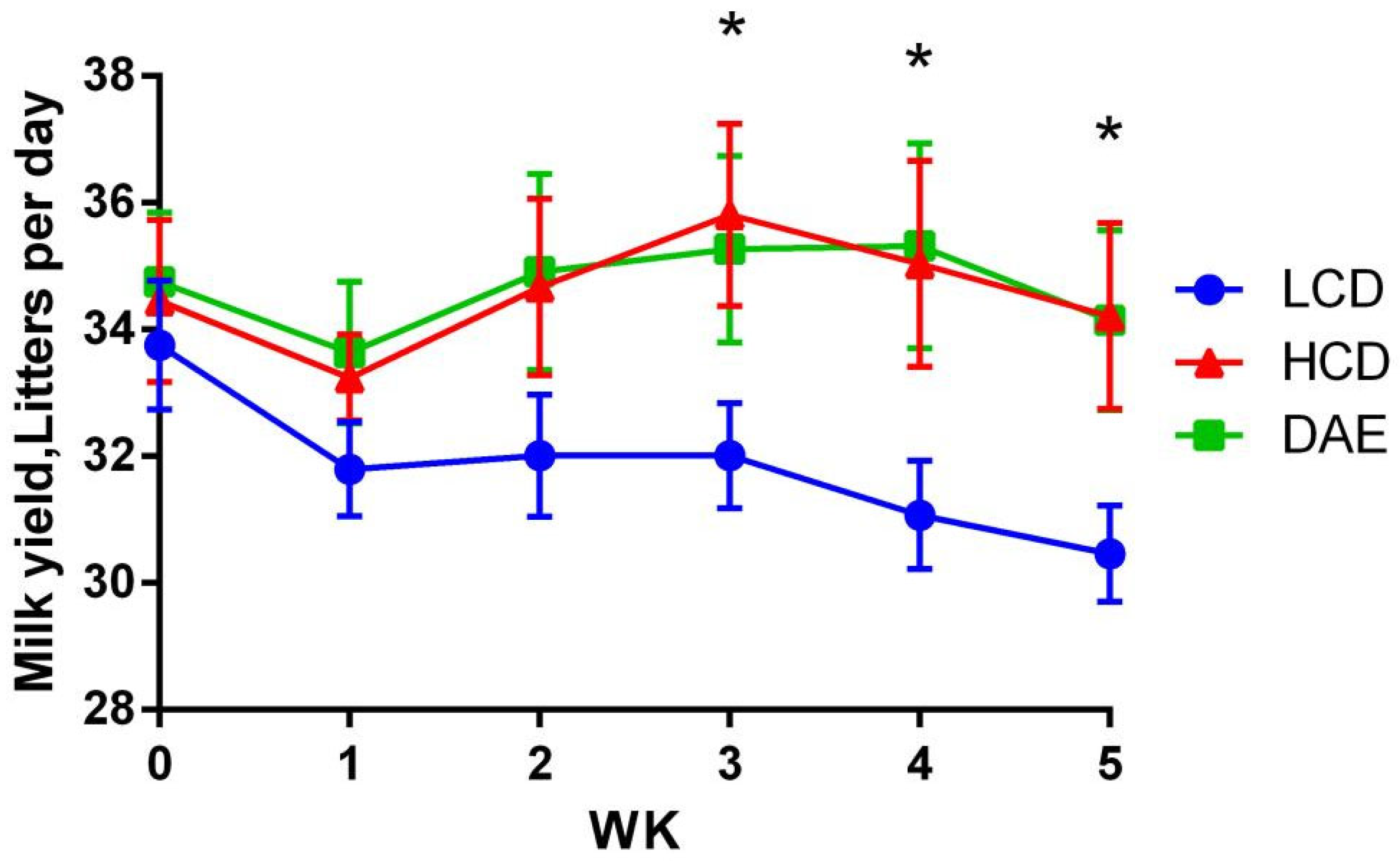

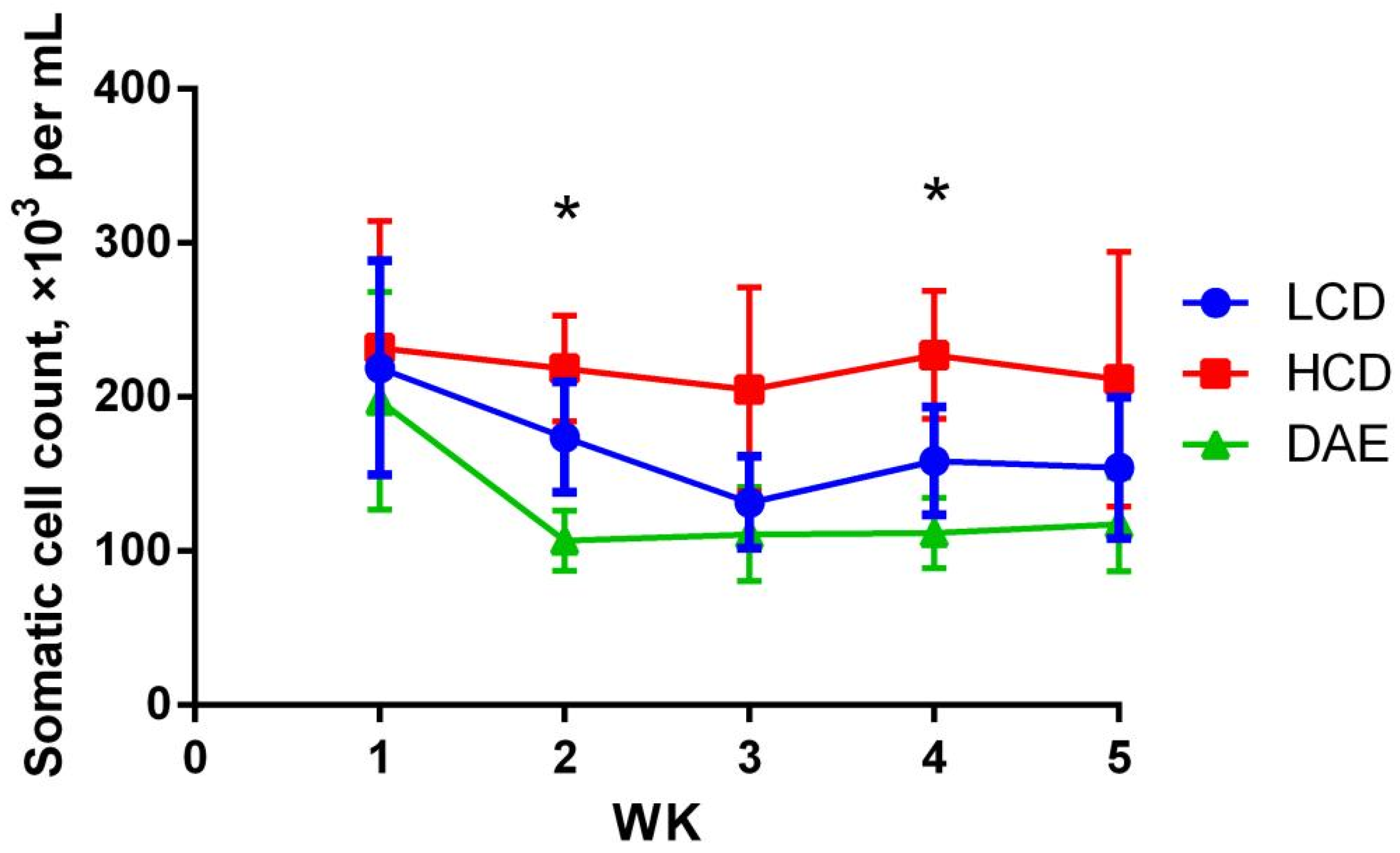
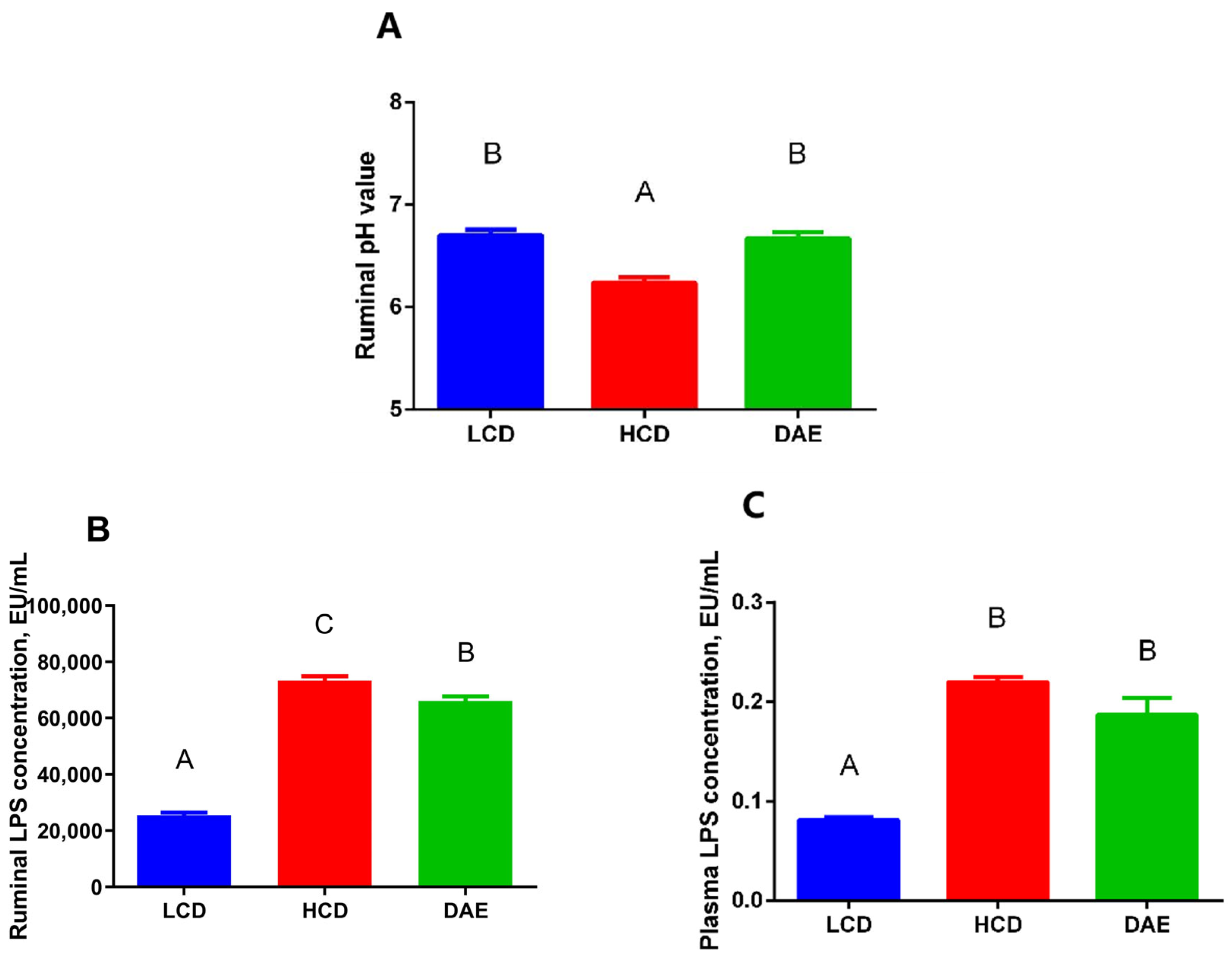
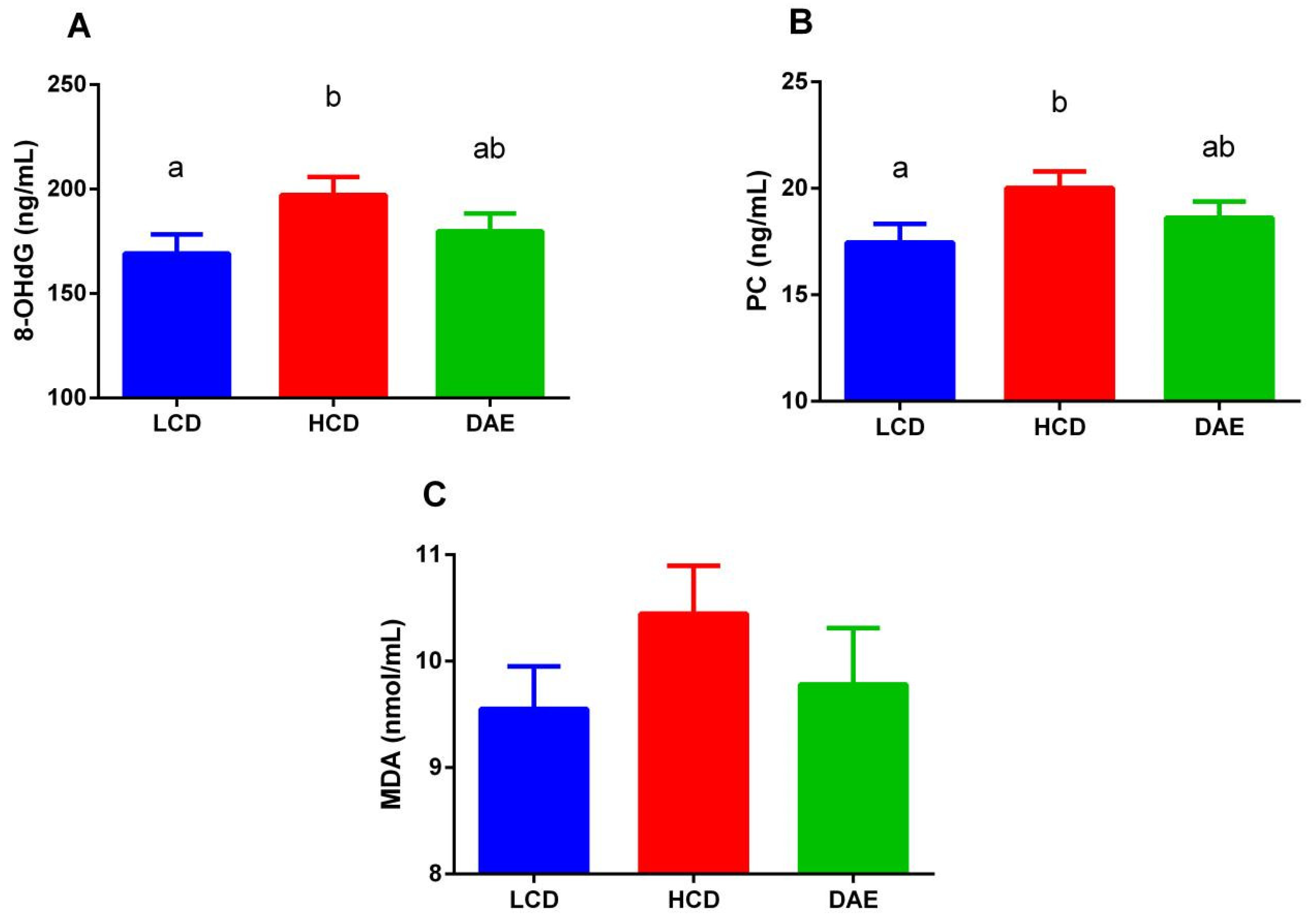
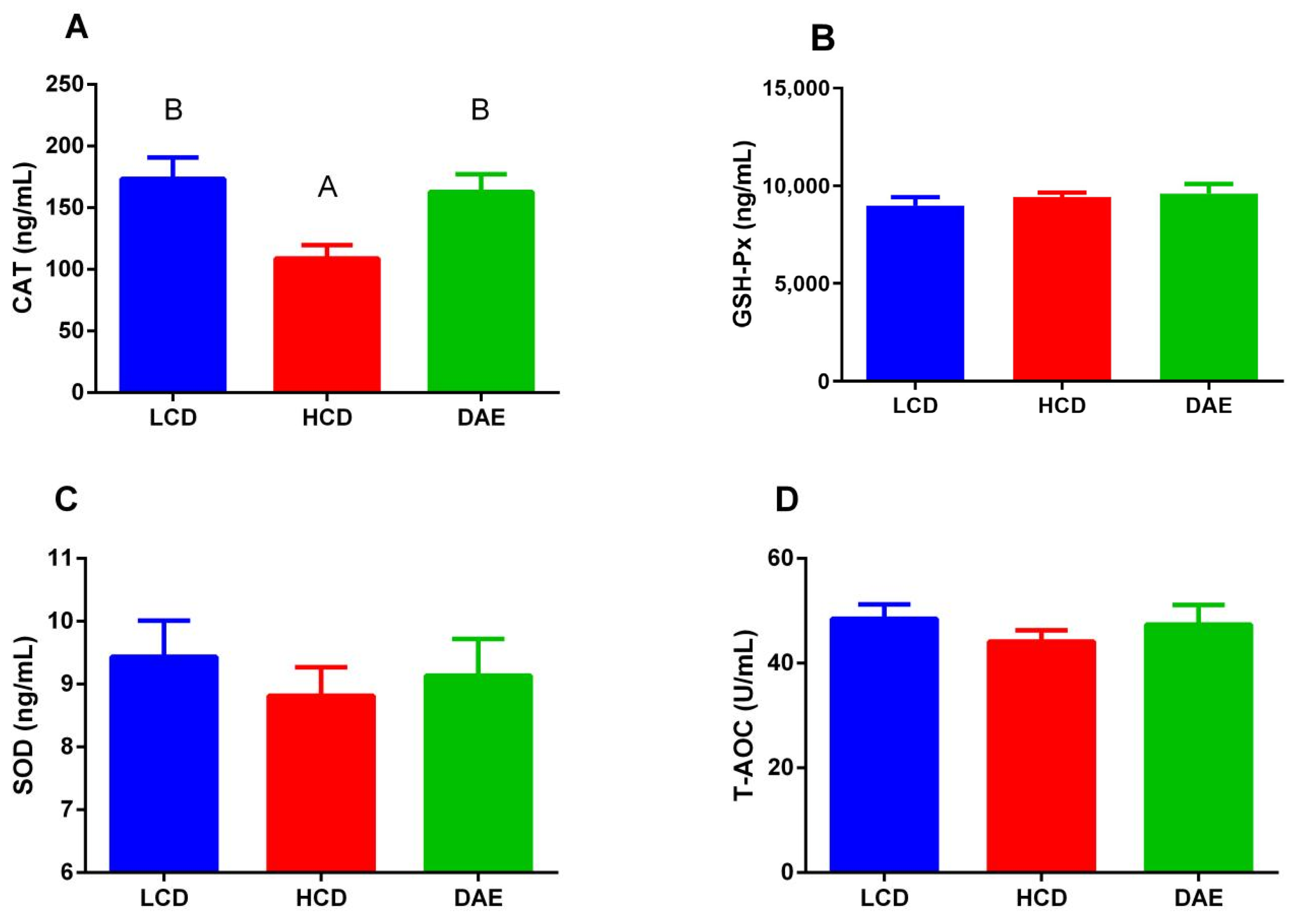


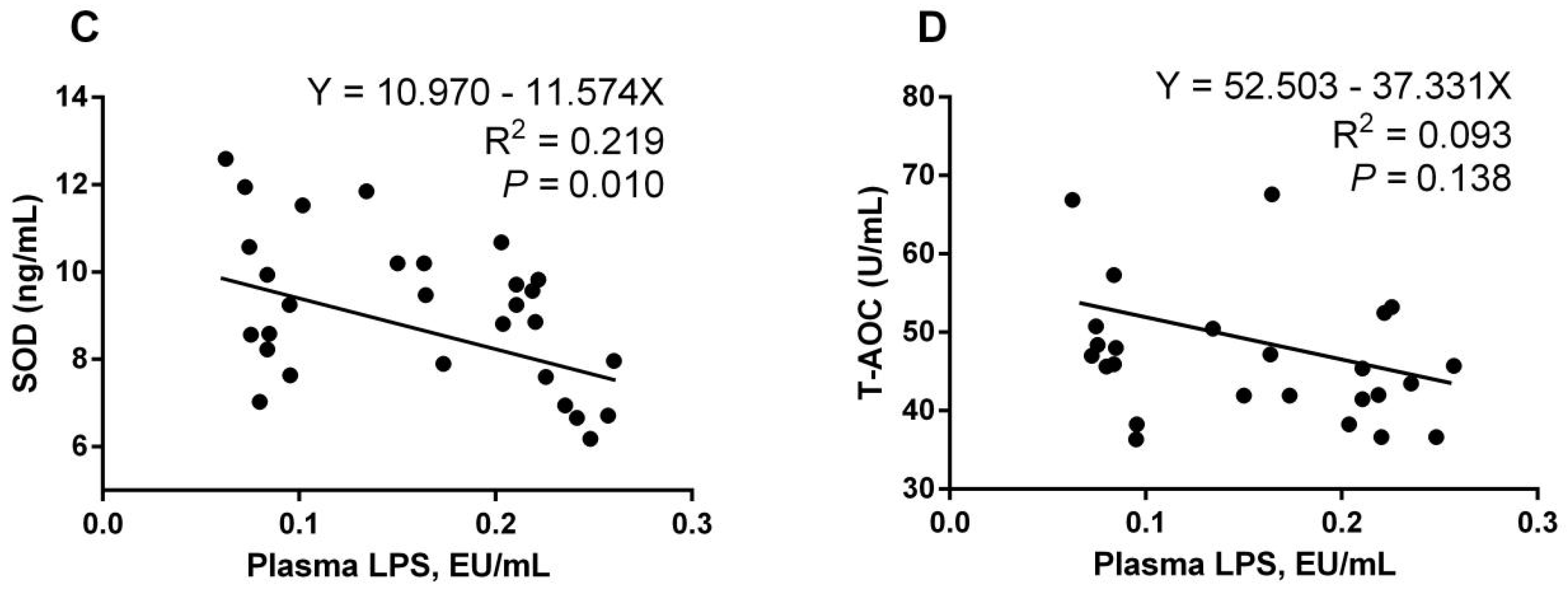
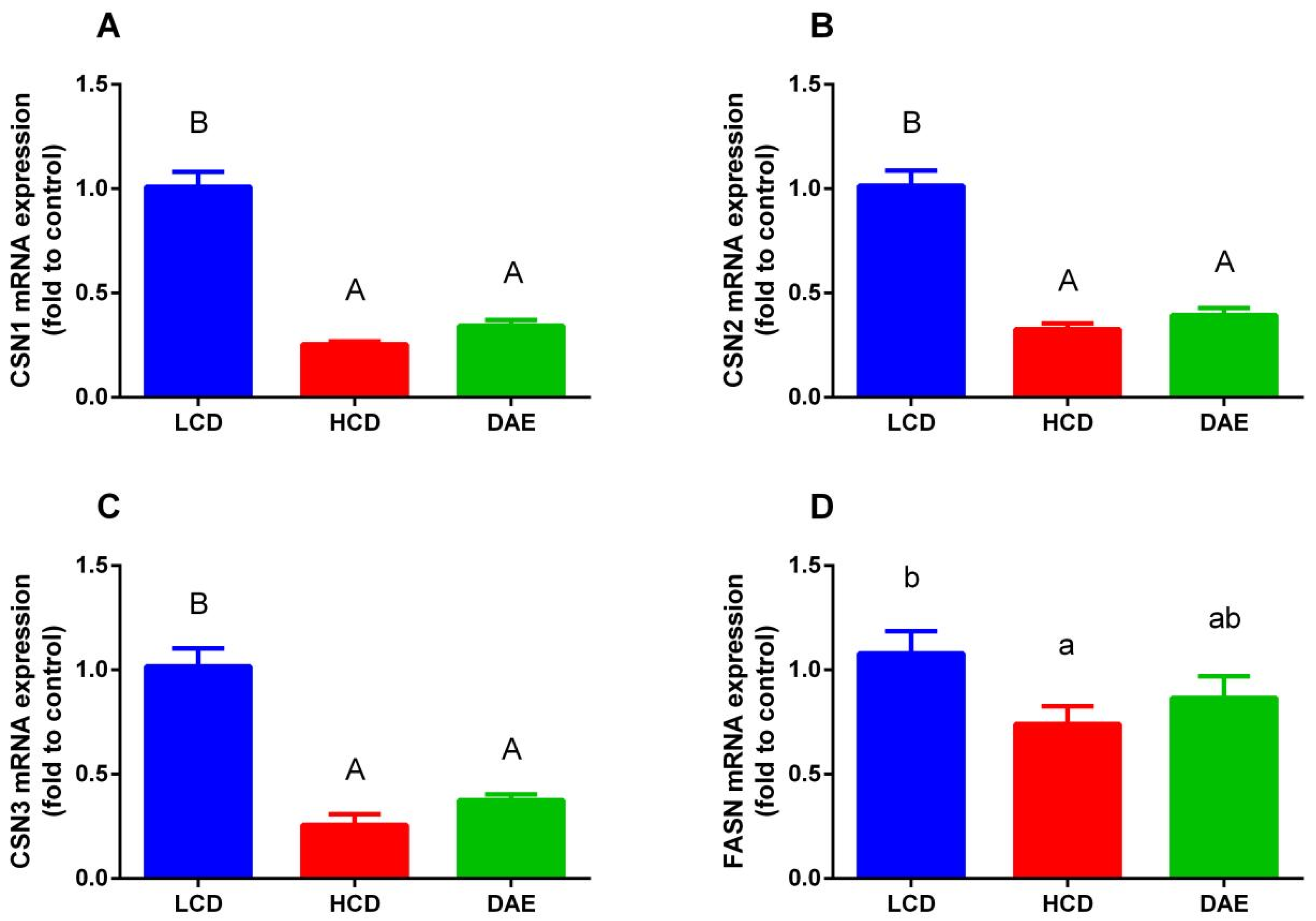

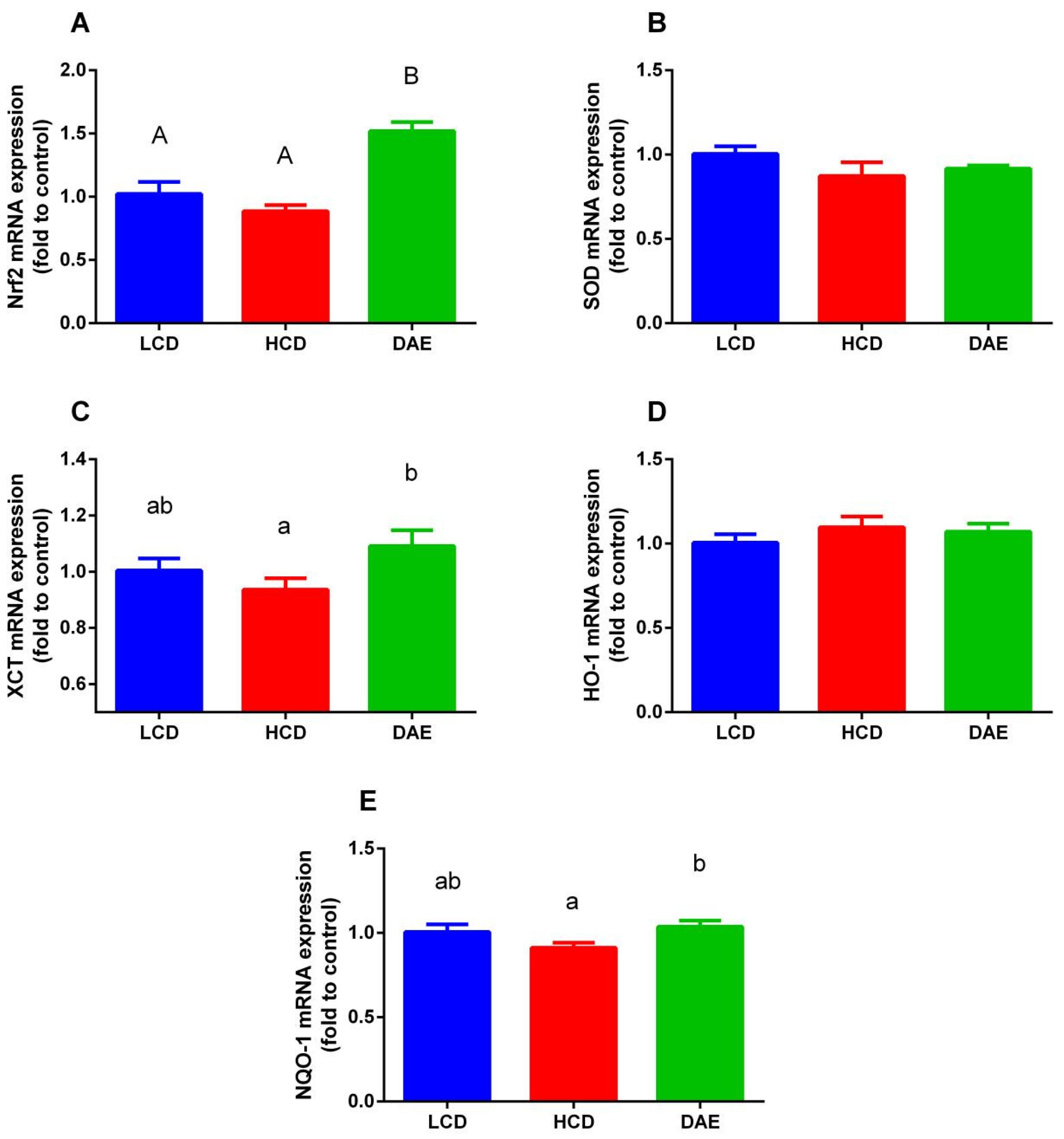
| Item | Treatment 1 | SEM | p-Value | ||
|---|---|---|---|---|---|
| LCD | HCD | DAE | |||
| Week 1 | |||||
| Butterfat (%) | 4.06 | 3.23 | 3.51 | 0.366 | 0.091 |
| Solid non-fat (%) | 8.79 | 8.98 | 8.84 | 0.133 | 0.400 |
| Intensity (kg/m3) | 30.88 a | 32.60 b | 31.62 ab | 0.635 | 0.041 |
| Protein (%) | 3.43 | 3.50 | 3.45 | 0.049 | 0.379 |
| Lactose (%) | 4.98 | 5.08 | 5.00 | 0.075 | 0.451 |
| Week 2 | |||||
| Butterfat (%) | 2.90 | 2.79 | 3.00 | 0.276 | 0.754 |
| Solid non-fat (%) | 8.32 A | 8.24 A | 8.59 B | 0.099 | 0.003 |
| Intensity (kg/m3) | 29.61 a | 30.05 ab | 30.87 b | 0.437 | 0.018 |
| Protein (%) | 3.22 | 3.25 | 3.29 | 0.045 | 0.269 |
| Lactose (%) | 4.72 | 4.70 | 4.84 | 0.062 | 0.058 |
| Week 3 | |||||
| Butterfat (%) | 2.84 | 2.64 | 2.87 | 0.129 | 0.166 |
| Solid non-fat (%) | 8.39 A | 9.09 B | 8.94 B | 0.106 | <0.001 |
| Intensity (kg/m3) | 29.93 A | 33.14 C | 32.01 B | 0.477 | <0.001 |
| Protein (%) | 3.24 A | 3.29 A | 3.37 B | 0.035 | 0.002 |
| Lactose (%) | 4.77 A | 5.12 B | 5.06 B | 0.058 | <0.001 |
| Week 4 | |||||
| Butterfat (%) | 3.12 | 3.03 | 3.05 | 0.129 | 0.761 |
| Solid non-fat (%) | 8.65 a | 9.02 b | 8.96 B | 0.125 | 0.012 |
| Intensity (kg/m3) | 30.62 A | 32.49 B | 32.07 B | 0.453 | 0.001 |
| Protein (%) | 3.32 | 3.39 | 3.33 | 0.374 | 0.376 |
| Lactose (%) | 4.86 A | 5.11 B | 5.07 B | 0.071 | 0.003 |
| Week 5 | |||||
| Butterfat (%) | 3.03 b | 2.67 a | 2.84 ab | 0.120 | 0.018 |
| Solid non-fat (%) | 8.70 | 8.86 | 8.70 | 0.109 | 0.309 |
| Intensity (kg/m3) | 31.11 | 31.95 | 31.35 | 0.358 | 0.069 |
| Protein (%) | 3.28 | 3.30 | 3.34 | 0.030 | 0.110 |
| Lactose (%) | 4.94 | 5.02 | 4.93 | 0.064 | 0.322 |
| Item | Treatment 1 | ||
|---|---|---|---|
| LCD | HCD | DAE | |
| Ingredient (% DM) | |||
| Leymus chinensis | 14.82 | 6.06 | 6.01 |
| Corn silage | 21.99 | 13.93 | 13.89 |
| Alfalfa hay | 12.70 | 10.97 | 10.92 |
| Fresh distiller’s grains | 5.85 | 3.61 | 3.64 |
| Sugar beet meal | 4.39 | 3.91 | 3.86 |
| Cottonseed | 0.00 | 1.73 | 1.74 |
| Corn | 21.79 | 32.37 | 32.20 |
| Wheat bran | 1.57 | 3.44 | 3.44 |
| Palm oil | 1.09 | 1.58 | 1.55 |
| Soybean meal | 5.48 | 7.74 | 7.73 |
| Cottonseed meal | 2.76 | 3.99 | 3.95 |
| Distiller dried grain with solubles (DDGS) | 3.88 | 5.63 | 5.59 |
| Calcium hydrogen phosphate | 1.13 | 1.61 | 1.57 |
| Calcium carbonate (light powder) | 0.62 | 0.93 | 0.95 |
| Magnesium oxide | 0.24 | 0.33 | 0.32 |
| Salt | 0.41 | 0.46 | 0.48 |
| Vitamin and mineral premix 2 | 0.91 | 1.27 | 1.25 |
| Urea premix | 0.20 | 0.30 | 0.32 |
| Yeast premix | 0.17 | 0.14 | 0.13 |
| Dandelion aqueous extracts (DAEs) | 0.00 | 0.00 | 0.50 |
| Concentrate–forage | 4:6 | 6:4 | 6:4 |
| Nutrient composition 3 | |||
| Net energy for lactation (NEL, MJ/Kg) | 6.2 | 6.6 | 6.5 |
| Crude protein (% DM) | 15.4 | 16.1 | 16 |
| Ether extract (% DM) | 5.2 | 6 | 6 |
| Neutral detergent fiber (% DM) | 49.5 | 43.2 | 43 |
| Acid detergent fiber (% DM) | 22.5 | 18.9 | 18.8 |
| Calcium (% DM) | 1.04 | 1.04 | 1.03 |
| Total phosphorus (% DM) | 0.53 | 0.53 | 0.53 |
| Gene | Primer Sequence | Product Size (bp) | GenBank Accession No. |
|---|---|---|---|
| HO-1 | F: GGCAGCAAGGTGCAAGA | 221 | NM_001014912.1 |
| R: GAAGGAAGCCAGCCAAGAG | |||
| SOD | F: GAGGCAAAGGGAGATACAGTC | 197 | NM_174615.2 |
| R: GTCACATTGCCCAGGTCTC | |||
| NQO-1 | F: GGTGCTCATAGGGGAGTTCG | 235 | NM_001034535.1 |
| R: GGGAGTGTGCCCAATGCTAT | |||
| XCT | F: GATACAAACGCCCAGATATGC | 136 | XM_002694373.2 |
| R: ATGATGAAGCCAATCCCTGTA | |||
| GAPDH | F: GGGTCATCATCTCTGCACCT | 177 | NM_001034034.2 |
Disclaimer/Publisher’s Note: The statements, opinions and data contained in all publications are solely those of the individual author(s) and contributor(s) and not of MDPI and/or the editor(s). MDPI and/or the editor(s) disclaim responsibility for any injury to people or property resulting from any ideas, methods, instructions or products referred to in the content. |
© 2024 by the authors. Licensee MDPI, Basel, Switzerland. This article is an open access article distributed under the terms and conditions of the Creative Commons Attribution (CC BY) license (https://creativecommons.org/licenses/by/4.0/).
Share and Cite
Zhang, Y.; Mgeni, M.; Xiu, Z.; Chen, Y.; Chen, J.; Sun, Y. Effects of Dandelion Extract on Promoting Production Performance and Reducing Mammary Oxidative Stress in Dairy Cows Fed High-Concentrate Diet. Int. J. Mol. Sci. 2024, 25, 6075. https://doi.org/10.3390/ijms25116075
Zhang Y, Mgeni M, Xiu Z, Chen Y, Chen J, Sun Y. Effects of Dandelion Extract on Promoting Production Performance and Reducing Mammary Oxidative Stress in Dairy Cows Fed High-Concentrate Diet. International Journal of Molecular Sciences. 2024; 25(11):6075. https://doi.org/10.3390/ijms25116075
Chicago/Turabian StyleZhang, Yan, Musa Mgeni, Ziqing Xiu, Yu Chen, Juncai Chen, and Yawang Sun. 2024. "Effects of Dandelion Extract on Promoting Production Performance and Reducing Mammary Oxidative Stress in Dairy Cows Fed High-Concentrate Diet" International Journal of Molecular Sciences 25, no. 11: 6075. https://doi.org/10.3390/ijms25116075





